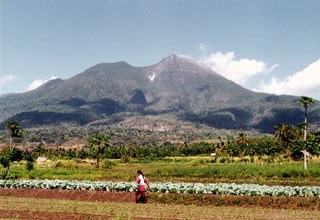Report on Egon (Indonesia) — 13 January-19 January 2016
Smithsonian Institution / US Geological Survey
Weekly Volcanic Activity Report, 13 January-19 January 2016
Managing Editor: Sally Sennert.
Please cite this report as:
Global Volcanism Program, 2016. Report on Egon (Indonesia) (Sennert, S, ed.). Weekly Volcanic Activity Report, 13 January-19 January 2016. Smithsonian Institution and US Geological Survey.
Egon
Indonesia
8.676°S, 122.455°E; summit elev. 1661 m
All times are local (unless otherwise noted)
PVMBG reported that during 1-12 January seismicity at Egon was dominated by shallow volcanic tremor, harmonic tremor, and signals indicating emissions. Seismicity had increased on 15 December 2015, and then fluctuated through 11 January. RSAM increased significantly on 12 January due to an earthquake detected at 0936. PVMBG noted that the pattern of seismicity was similar to that observed before a phreatic eruption on 15 April 2008. The Alert Level was raised to 2 (on a scale of 1-4) and residents were advised to stay at least 3 km away from the crater.
On 20 January BNPB reported that activity increased again, prompting the PVMBG to raise the Alert Level to 3. The report noted that access to the Mapitara district was closed due to a strong sulfur dioxide odor in that area, and that 927 people living within 3 km of the volcano had been evacuated (501 people refused to evacuate). Diffuse white plumes rose as high as 50 m above the crater.
Geological Summary. Gunung Egon, also known as Namang, sits within the narrow section of eastern Flores Island. The barren, sparsely vegetated summit region has a 350-m-wide, 200-m-deep crater that sometimes contains a lake. Other small crater lakes occur on the flanks. A lava dome forms the southern summit. Solfataric activity occurs on the crater wall and rim and on the upper S flank. Reports of eruptive activity prior to explosive eruptions beginning in 2004 are unconfirmed. Emissions were often observed above the summit during 1888-1892. Strong emissions in 1907 reported by Sapper (1917) was considered by the Catalog of Active Volcanoes of the World (Neumann van Padang, 1951) to be an historical eruption, but Kemmerling (1929) noted that this was likely confused with an eruption on the same date and time from Lewotobi Lakilaki.
Sources: Pusat Vulkanologi dan Mitigasi Bencana Geologi (PVMBG, also known as CVGHM), Badan Nacional Penanggulangan Bencana (BNPB)

